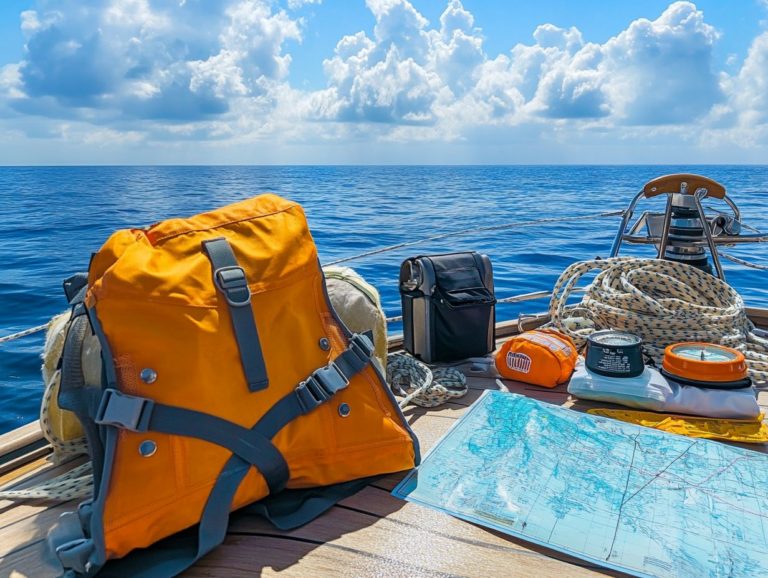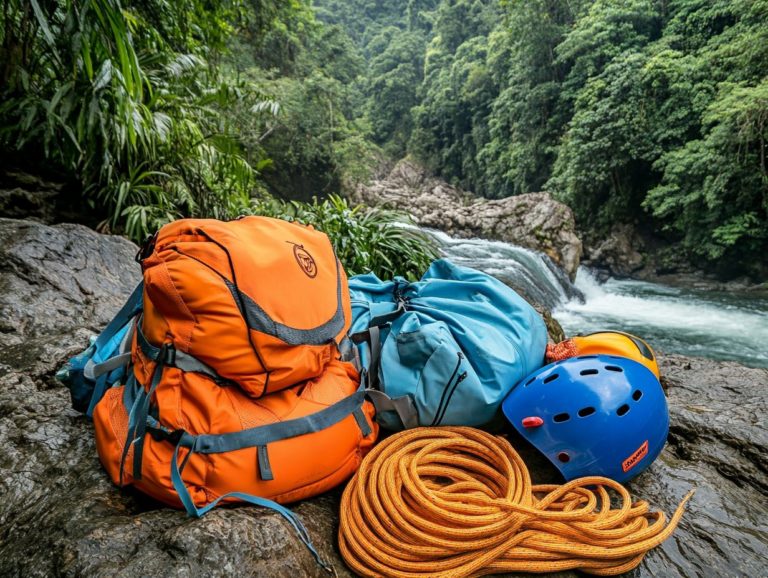Safety Tips for Jet Skiing: What You Need
Jet skiing presents an exhilarating opportunity to explore the water, yet prioritizing safety is very important.
This guide is here to help you discover essential safety gear that will keep you safe and having fun! It delves into crucial measures to prevent accidents and fundamental techniques that will elevate your riding experience. You ll also find vital maintenance tips to keep your jet ski in peak condition and outlines of the local laws and regulations you should be aware of.
Whether you’re just starting or are a seasoned rider, this guide equips you with everything you need to be thoroughly prepared for your next adventure on the waves.
Contents
- Key Takeaways:
- What is Jet Skiing?
- Essential Safety Gear for Jet Skiing
- Preventing Accidents on a Jet Ski
- Basic Jet Skiing Techniques
- Jet Ski Maintenance and Inspection
- Jet Skiing Rules and Regulations
- Frequently Asked Questions
- What are the essential items you need for safe jet skiing?
- Why is it important to wear a life jacket while jet skiing?
- Do I need a whistle while jet skiing?
- What should I do if I encounter bad weather while riding a jet ski?
- Do I need to know how to swim before going jet skiing?
- Is a fire extinguisher necessary while jet skiing?
Key Takeaways:
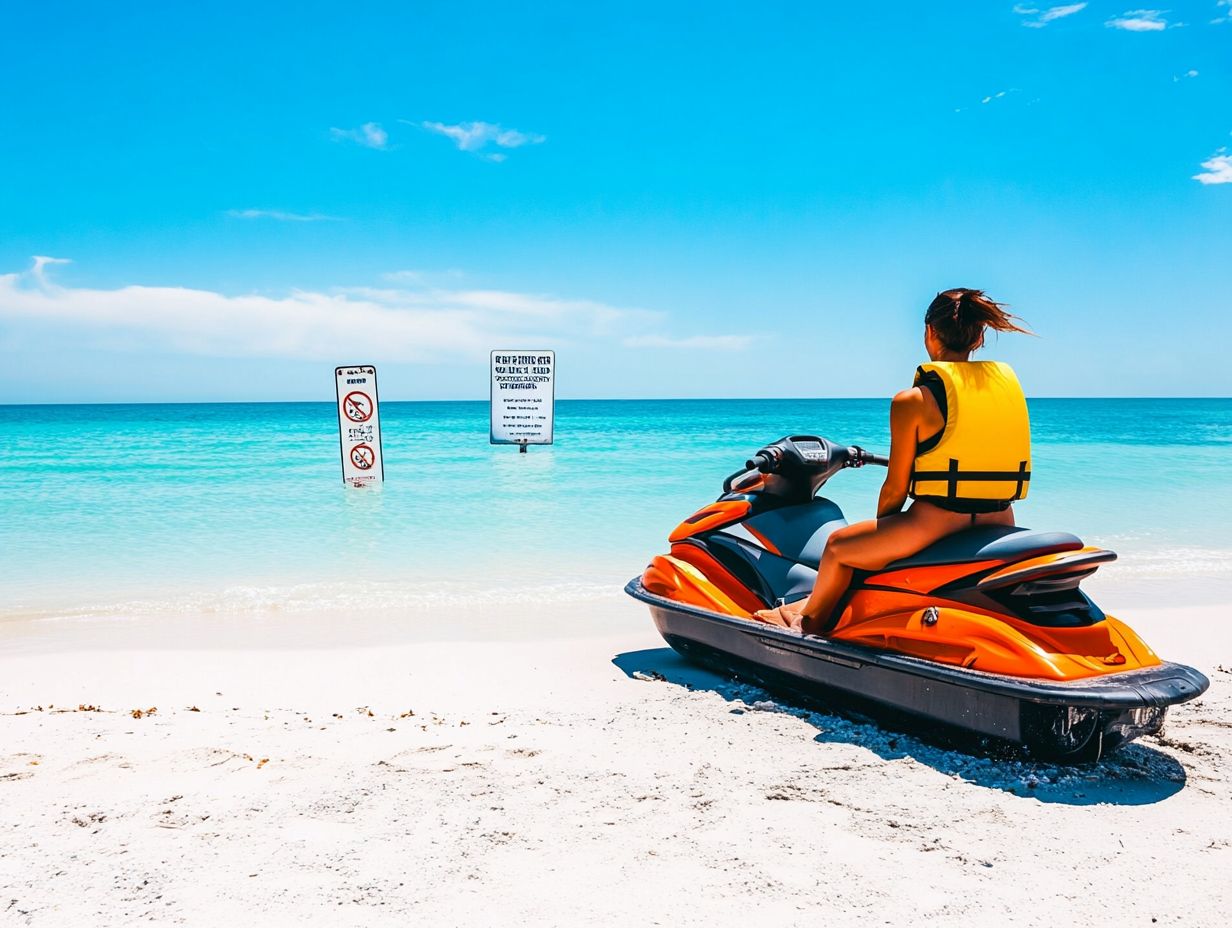
- Wear protective gear, such as a life jacket and helmet, while jet skiing to prevent accidents and injuries.
- Before operating a jet ski, familiarize yourself with local laws and regulations to ensure a safe and legal ride.
- Proper maintenance and inspection of your jet ski is crucial for a safe and enjoyable experience on the water.
What is Jet Skiing?
Jet skiing is the ultimate thrill on water, allowing you to hop onto a personal watercraft like a Jet Ski, WaveRunner, or Sea-Doo and glide across lakes, rivers, and oceans. This exciting activity combines speed, control, and fun, making it a top pick for adventure enthusiasts every summer.
Whether you re racing friends or leisurely cruising along the shoreline, jet skiing offers a remarkable opportunity to connect with marine life and discover stunning waterways.
Originating in the late 1960s with the first commercial models, personal watercraft have evolved significantly. They present a range of designs tailored to various preferences and skill levels. Today, you can choose from nimble stand-up models perfect for tricks or sit-down models that provide comfort for extended rides.
As with any water sport, safety is key. It’s crucial to wear life jackets, stay alert to buoy markers, and familiarize yourself with local regulations to ensure a safe and enjoyable outing.
The allure of jet skiing lies not only in the exhilarating speed but also in the freedom it grants you to explore coastal stretches, rivers, and breathtaking landscapes. This activity is accessible to both beginners and seasoned riders alike.
Essential Safety Gear for Jet Skiing
When you set out on a jet skiing adventure, prioritizing safety is very important. Equip yourself with essential safety gear to safeguard against potential accidents and guarantee an enjoyable experience on the water.
Key items in your arsenal should include:
- Properly fitted life jacket
- Sturdy watercraft helmet
- Emergency lanyard
- Well-stocked first-aid kit
Together, these items significantly enhance your safety while navigating personal watercraft. By adhering to these precautions, you not only align with boating regulations but also prepare yourself for any unexpected situations that may arise.
Protective Clothing and Equipment
Wearing the right protective clothing and equipment is essential for safe jet skiing, allowing you to fully enjoy your adventure while minimizing the risk of injury. Start with a well-fitting life jacket to keep you afloat, add some neoprene shorts for comfort and thermal protection, and top it off with a sturdy watercraft helmet that meets Coast Guard safety standards.
This combination of protective gear elevates your boating safety, ensuring you’re ready for anything that comes your way during your water escapades. Opting for a wetsuit can provide extra buoyancy and protection from harsh weather conditions, significantly enhancing your comfort during those longer rides.
Footwear designed specifically for aquatic sports not only safeguards your feet but also offers improved grip, reducing the chances of slips when boarding or disembarking.
Each piece of this protective ensemble meets rigorous safety standards while ensuring your personal comfort an absolute must when navigating through choppy waters. Invest in UV-protective clothing to shield you from harmful sun exposure, aligning perfectly with regulations that promote overall rider safety.
Preventing Accidents on a Jet Ski
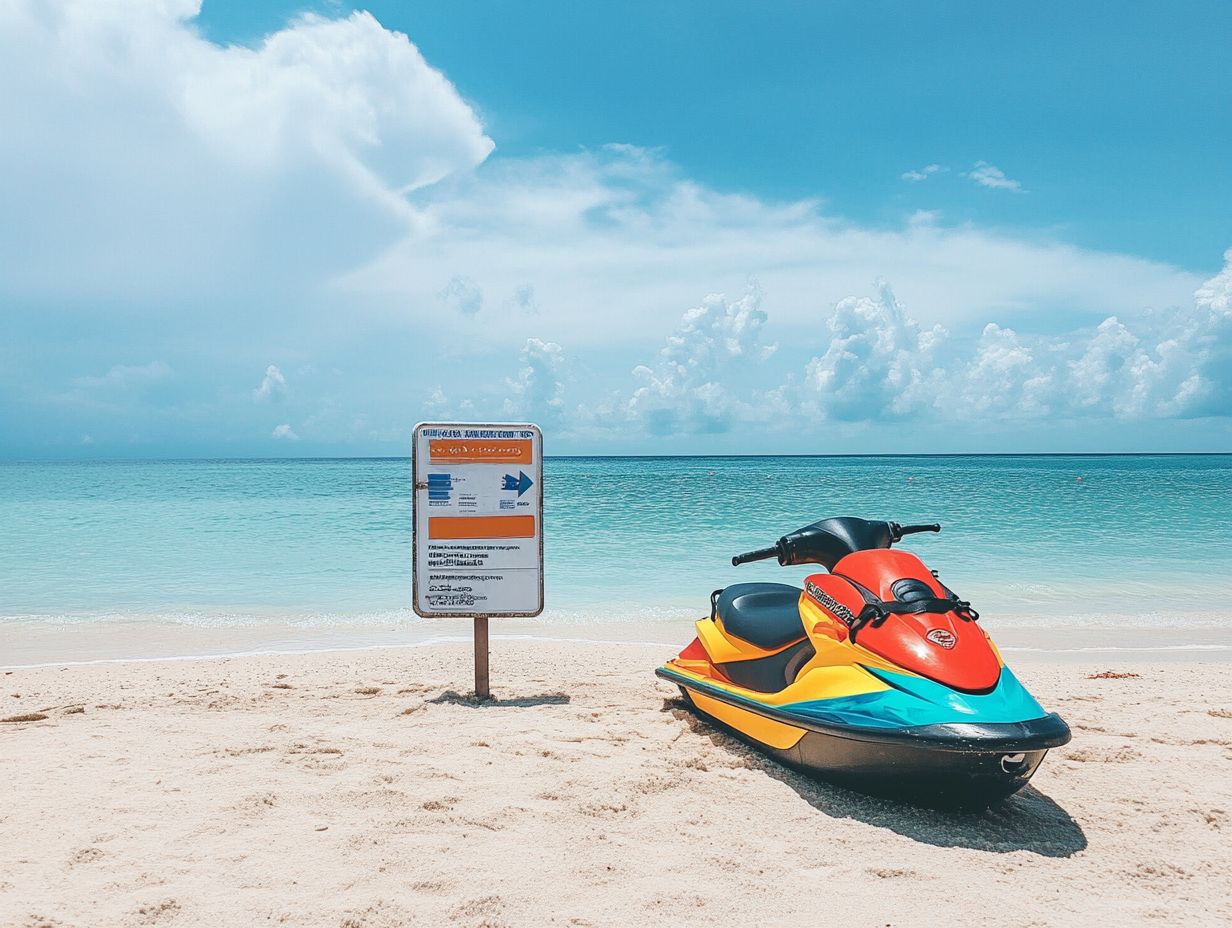
Preventing accidents while Jet Skiing is essential for ensuring a safe and enjoyable experience on the water. You can ensure safety by following these exciting tips!
By understanding speed limits and maintaining a safe distance from other watercraft, you can significantly minimize the risk of accidents and injuries. Familiarizing yourself with local regulations and best practices will enhance your skills and boost your confidence as a personal watercraft (PWC) operator.
Key Safety Measures
Implementing key safety measures while Jet Skiing can significantly enhance your experience and reduce the risk of accidents on the water.
Enrolling in a boating safety course is highly advisable. It equips you with essential skills in collision avoidance, emergency response, and the safe operation of personal watercraft.
Utilizing an emergency lanyard connects you directly to your PWC, ensuring it stays within reach even if you take a tumble, further bolstering your safety on the water.
Beyond basic safety gear, being aware of your surroundings is crucial. Keep an eye out for other vessels, swimmers, and potential obstacles lurking beneath the surface. Understanding weather conditions is equally vital stormy seas or high winds can create serious hazards. Checking forecasts before you embark can help you avoid perilous situations.
Having a pre-planned route that you share with someone on land ensures you don’t wander too far off course. This enables emergency services to locate you swiftly if needed. Organizations like the Coast Guard play an invaluable role in promoting boating safety, providing resources, and conducting drills to prepare you for emergencies.
Awareness and preparation are essential components for enjoying a safe Jet Skiing adventure.
Basic Jet Skiing Techniques
Mastering the fundamentals of Jet Skiing is crucial for ensuring both safety and enjoyment during your rides. A solid grasp of throttle control and maneuverability can greatly elevate your performance on the water.
By mastering throttle control, you can seamlessly adjust your speed to match varying conditions while maintaining stability during turns. Embracing effective driving tips will help you navigate around obstacles and other watercraft with grace, fostering a sense of confidence and skill in operating your personal watercraft.
How to Handle a Jet Ski
Handling a Jet Ski effectively means grasping its maneuverability and mastering throttle control to navigate the water with both safety and finesse.
Familiarizing yourself with these key aspects not only elevates your experience but also ensures the safety of both you and those nearby. For instance, acceleration should be gradual; a sudden jolt on the throttle can easily throw you off balance, particularly when you’re tackling waves. When turning, lean into the curve while keeping a steady speed; this balance is crucial to prevent capsizing.
Stopping should be a smooth operation; easing off the throttle well before reaching an obstacle grants you better control and helps you avoid abrupt halts that could lead to injury. By practicing these maneuvers in calm waters, you can significantly increase your proficiency and confidence, transforming yourself from a novice into a skilled operator of your personal watercraft.
Jet Ski Maintenance and Inspection
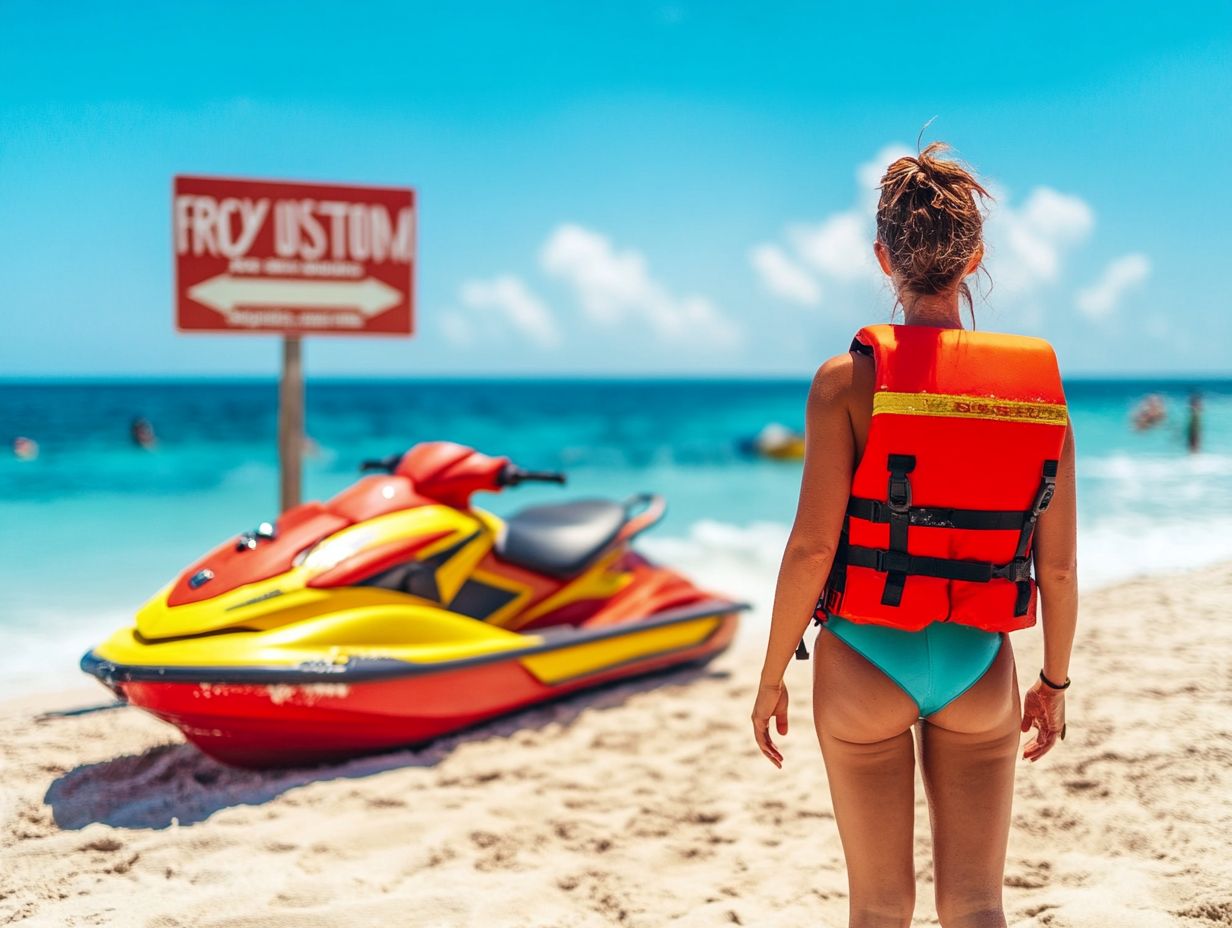
Regular maintenance and inspection of your Jet Ski are essential for ensuring optimal performance, safety, and the longevity of your personal watercraft. Don t wait for issues to arise regular checks can save your summer fun!
This means closely following the operating manual, adhering to the recommended service intervals, and paying attention to key components like the engine, fuel system, and safety equipment.
By conducting thorough inspections and performing necessary maintenance, you can prevent potential issues and relish seamless water activities all summer long.
Start practicing these techniques today for a safer and more thrilling ride!
Regular Maintenance and Inspection Tips
Keep your Jet Ski in great shape by following the maintenance tips in your manual. This helps you avoid costly repairs and stay safe on the water.
Start with a thorough check of your battery. Ensure the terminals are clean and corrosion-free, and confirm it’s holding a charge.
Next, inspect your spark plugs. These are essential for igniting the fuel. Replace any worn plugs to boost your Jet Ski’s performance.
Regularly check your safety gear, including life jackets and flares. Stay prepared for emergencies!
Jet Skiing Rules and Regulations
Understanding the rules and regulations of jet skiing is essential for a safe and enjoyable experience on the water. By complying with boating laws and local restrictions, you not only safeguard yourself but also protect the marine environment.
These regulations vary significantly by location, covering speed limits, designated areas for personal watercraft operation, and required safety equipment such as a life jacket and watercraft helmet. Knowing these laws promotes responsible riding and allows you to contribute positively to the boating community.
Understanding Local Laws and Restrictions
Being aware of local laws is essential for you as a Jet Skier to ensure compliance and safety while enjoying water activities. These laws often set speed limits, safe paths on the water, and restricted environmental areas crucial for protecting marine life.
By understanding these regulations, you can navigate responsibly and minimize both risks and environmental impact, especially concerning potential fuel spills.
Each jurisdiction may designate specific zones for personal watercraft operations, emphasizing areas where speed limits are particularly strict to protect fragile ecosystems and ensure safety with other water users. As a Jet Ski enthusiast, pay attention to requirements for life jackets and other safety equipment, including emergency lanyards and first-aid kits, since local regulations can vary widely.
Resources like local government websites and boating safety courses provide valuable insights into these rules. This empowers you to make informed decisions that prioritize safety and environmental stewardship during every adventure while also offering driving tips and insights on jet ski maintenance.
Frequently Asked Questions

What are the essential items you need for safe jet skiing?
Essential items include a life jacket, whistle, flotation device, fire extinguisher, helmet, and a waterproof first-aid kit.
Why is it important to wear a life jacket while jet skiing?
Wearing a life jacket is crucial for jet skiing as it can save your life in case of an accident. It keeps you afloat and minimizes the risk of drowning, especially when combined with proper throttle control and collision avoidance techniques.
Do I need a whistle while jet skiing?
Yes, it is important to carry a whistle while jet skiing. It can help you signal for help if you get separated from your jet ski or encounter an emergency. It’s also wise to have a VHF radio for additional communication.
What should I do if I encounter bad weather while riding a jet ski?
If bad weather hits, head back to shore right away. If that isn’t possible, find a sheltered spot and wait for the storm to pass.
Always check the weather report before you go out!
Do I need to know how to swim before going jet skiing?
Knowing how to swim is not a requirement, but it s strongly advised. It helps you stay calm during unexpected situations.
This is especially true when wearing special gear like neoprene shorts, which keep you warm and protected.
Is a fire extinguisher necessary while jet skiing?
Yes, having a fire extinguisher on your jet ski is crucial for safety. It helps you quickly put out a fire and prevents further damage.
This is a recommendation from the Coast Guard.

